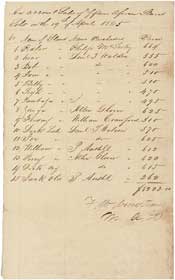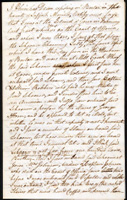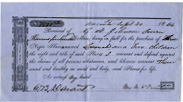Slavery and Emancipation: Federal Document Sources from Atlanta, Boston, New York, and Philadelphia
The Slave Trade
Contents
- Our Records
- The Slave Trade
- Fugitive Slaves
- Freedmen and Civil Rights
At the Constitutional Convention in 1787, delegates fiercely debated the issue of slavery, but ultimately agreed that United States would cease its engagement in the transatlantic slave trade in 1808. While American vessels, as of this date, no longer traveled to Africa in search of human merchandise, a domestic or "coastwise" trade in slaves persisted between ports within the United States, as demonstrated by Slave Manifests and court records.
The Amistad Africans
Examine the trial answers of S. Staples, R. Baldwin, and T. Sedgewick, Proctors for the Amistad Africans, to the several libels of Lt. Gedney, et. al. and Pedro Montes and Jose Ruiz, January 7, 1840.
The answers conveyed the position of the Africans and exposed the evils of slavery.
Documents from the Northeast Region ~ Boston
The court case, U.S. v. Schooners
Schooners Constitution, Merino, Louisa, and 84 Slaves, Mixed Cases, dated 1825 tells the story of the illegal importation of slaves. The captain of the ship was convicted and the ship's cargo, including the slaves, sold and the proceeds of the sale turned over to the court. The following "Account of the Sale of fifteen African Slaves Sold on the 19th of April 1825" lists the fifteen slaves and their sale price.
Documents from the Southeast Region ~ Atlanta
The Schooner Patuxent
The Schooner Patuxent left the Port of New York for the Coast of Africa. While off Cape Mount, she was seized by the U.S.S. Yorktown. The Yorktown was part of the "African Squadron" commissioned to help curtail the slave trade. The crew of the Patuxent was arrested for participating in the illegal slave trade. The ship was found with ample supplies used in promoting the slave trade. With only circumstantial evidence, however, the captain and crew were found not guilty.
Read the order for Captain David of the Patuxent to appear in court.
Examine the deposition by William Chandler of the U.S.S. Yorktown stating that he believed the ship was rigged and carried extra supplies used to transport slaves.
Read the Act of Congress dated March 2, 1819 on Regulating Passenger Ships and Vessels.
Documents from the Northeast Region ~ New York City
The Ship Ohio
Examine the Slave Manifest of the Ship Ohio, May 3, 1821, including the sworn statement of the ship captain that he was not engaged in the transatlantic slave trade. This manifest shows two enslaved females - Betsey and Harriet - being transported from New Orleans to Philadelphia in 1821. A manifest is a list of passengers or cargo aboard a ship.
Documents from the MidAtlantic Region ~ Philadelphia
The Schooner Charming Sally
Read about a case involving a slave trader charged with illegal transportation of slaves.
Documents from the Northeast Region ~ Boston
Bills of Sale, 1864
Even though Abraham Lincoln issued the Emancipation Proclamation in 1863, slaves were still being bought and sold in the south. Bills of Sale for slaves in Georgia were recovered when the U.S. Navy intercepted the southern ship Mary and claimed both the ship and its contents as prize. Examine the 1864 Bill of Sale for a slave named Henry and for Suzannah and two children.
Documents from the Northeast Region ~ New York City
Slave manifests document the transportation of slaves throughout the southern ports
Examine this ship manifest of Negroes, mulattos and persons of color, bound for Mobile Alabama, 1844. This record from the Collector of Customs, U.S. Customs Service, notes the name, age, sex and owner for said slave.
Documents from the Southeast Region ~ Atlanta
Related Resources
View our online lesson plan for the Amistad Case.Learn about other records related to African-Americans and the slave trade in ARC (Archival Research Catalog).
Read the Emancipation Proclamation of 1863.
Examine the text of the 14th Amendment to the U.S. Constitution.
Questions for Discussion
- Slavery was an aspect of southern life, yet northern cities such as Boston, New York, and Philadelphia were involved in the slave trade - Why?
- Looking at the Amistad records, list what they tell you about a slave's life.
- In the Patuxent case, explore why the U.S. Navy and their special "African Squadron" had become involved in curtailing the international slave trade. Discuss why this was important.
- In the slave manifest from NARA's Mid-Atlantic Region, two enslaved women were transported from New Orleans to Philadelphia. What circumstances may have caused their relocation?
- How were the transatlantic slave trade and the domestic or "coastwise" slave trade (mentioned in conjunction with the Slave Manifest of the ship Ohio) different?
- Take sides. New York was a major center for abolitionist and anti abolitionist movements. Consider your self an abolitionist in the North. How would you react to seeing the slave receipt? Write an editorial about those feelings.
- Discuss what it would be like to be a slave.
- Reading the slave manifest in the 21st century, what can we say about 19th century attitudes on equality and how one "race" views another?
- Before 1808, intercostals manifests were not required because the Atlantic Slave Trade was legal. What does the existence of thousands of these manifests say about the federal government's relation to slavery after 1808?
- How would documents like these be useful in researching fugitive slaves in the 19th century?
- What other ways could slave manifests such as these prove useful for researchers today?
- Looking at the list of Slaves sold, what can this document tell us about how slaves were valued at the time?
- Consider what could have been the possible fate of slaves found to be brought into the U.S. illegally?
- If a slave managed to obtain their freedom while still in the U.S., how might their life have been different if they remained in the South? How would it be different if they went to the North?
- After the Civil War and the passage of the 13th Amendment, how would documents like the bill of sale help the fight for civil liberties for former slaves? How might they hurt the fight?
For more information about records available in these locations:
PDF files require the free Adobe Reader.
More information on Adobe Acrobat PDF files is available on our Accessibility page.


















